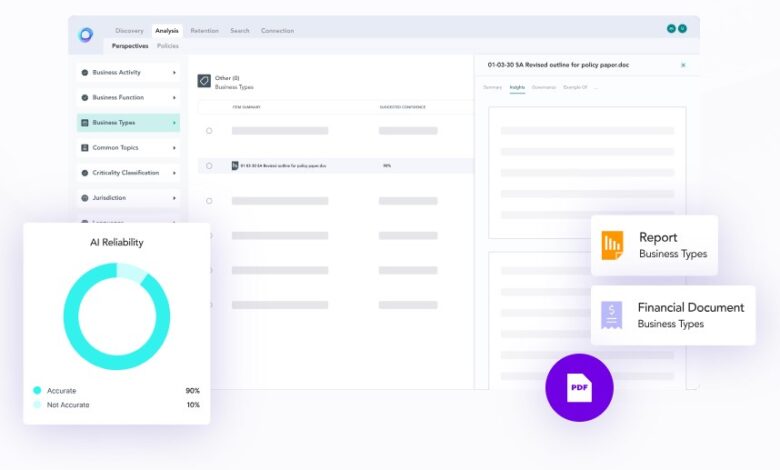
AI is no longer a futuristic concept—it’s here, transforming business operations. But for highly regulated enterprises, AI adoption comes with unique challenges. How can organizations trust AI to handle and protect sensitive data while ensuring compliance? The answer lies in a data-centric approach that prioritizes data quality, governance, and responsible deployment from the outset.
The Challenge—and the Solution
For AI to deliver accurate, reliable outcomes, it must be built on a foundation of high-quality data. Yet, many enterprises struggle with fragmented, unstructured, and siloed data that increases risk and hinders AI effectiveness. According to Gartner, over 75% of organizations state that AI-ready data remains one of their top five investment areas in the next two to three years. However, nearly two-thirds (65%) of organizations either do not have AI-ready data or are unsure, and 63% admit they lack the right data management practices for AI. Without addressing these gaps, AI initiatives will fall short of their potential.
To unlock AI’s power safely, organizations must take a strategic approach to:
- Discover all data assets, regardless of format, structure, or location.
- Understand data through intelligent metadata extraction and classification.
- Govern data with automated policies that enforce security, compliance, and lifecycle management.
- Use enriched, governed data to power AI-driven initiatives efficiently and responsibly.
These principles guide enterprises through three essential phases of successful AI implementation: Data Foundation, Governance & Risk Mitigation, and AI Deployment & Optimization.
Phase 1: Building a Strong Data Foundation
A successful AI initiative begins with understanding the organization’s data landscape. This involves:
- Conducting a thorough inventory of structured, unstructured, and semi-structured data.
- Utilizing AI-powered discovery tools to classify sensitive information based on security, privacy, and business context.
- Applying intelligent metadata enrichment to establish a normalized, unified data layer.
- Implementing data quality processes to eliminate inconsistencies, errors, and redundancies.
Without this solid foundation, AI projects are at high risk of failure. Gartner predicts that through 2026, organizations that fail to implement AI-ready data practices will see over 60% of AI projects fail to deliver on business SLAs and ultimately be abandoned.
Phase 2: Governance & Risk Mitigation
With a strong data foundation in place, organizations must enact governance measures that mitigate risk and ensure compliance. Key actions include:
- Enforcing automated policies for data access, retention, and disposal.
- Strengthening security through access controls, encryption, and privileged access principles.
- Conducting real-time monitoring to proactively detect vulnerabilities and compliance gaps.
- Performing privacy impact assessments to mitigate risks associated with AI applications.
This phase not only protects sensitive data but also establishes regulatory guardrails that prevent AI from accessing restricted information.
Phase 3: AI Deployment & Optimization
With high-quality, well-governed data, organizations can confidently deploy AI for key business use cases. Best practices for responsible AI deployment include:
- Prioritizing AI use cases aligned with business objectives, such as process automation, risk mitigation, and decision support.
- Selecting AI models that fit specific enterprise needs, including generative AI, machine learning, and pre-trained models.
- Fine-tuning models using enriched, compliant data to ensure accuracy and minimize bias.
- Implementing human oversight with continuous monitoring and feedback loops to optimize AI performance.
By anchoring AI initiatives in high-quality, well-governed data, organizations can drive reliable and repeatable AI outcomes, all while improving efficiency and maintaining regulatory compliance.
The Key Takeaways
The AI landscape is evolving rapidly, and enterprises are moving from theoretical exploration to practical implementation. Early adopters have demonstrated that data quality is the cornerstone of successful AI implementations. Without a strong data foundation that first discovers, enriches, normalizes, and de-risks data, AI initiatives risk producing unreliable, biased, or non-compliant outcomes.
By adopting a data-centric approach, organizations can maximize AI’s potential while minimizing risk. AI itself can play a foundational role in data management, ensuring information is structured, enriched, and governed before deployment. Platforms like EncompaaS enable enterprises to accelerate AI adoption responsibly—by using AI to prepare and protect data at scale, so that it can be curated for accelerated AI success.
AI is here to stay. The challenge is not whether to adopt AI, but how to do so responsibly—and it all starts with data.



